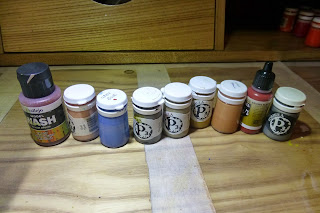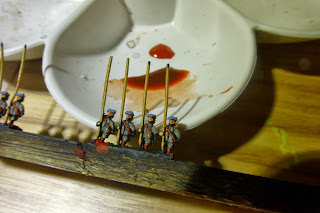The figures
Before I purchased the figures I called Pete at Baccus just to make sure that I was getting the right models, the pike are depicted on his website as part of a mixed unit as they belong to the ECW range and are shown with musket's.
Out the packet.......
I have mixed opinions on Baccus figures. My plus points are that they come in strips and for a pike army this is a big help. My Swiss army which is all Heroics & Ros took an age to individually base every model and was a real pain to get the figures based. Another plus is the quality of the castings.
There is very little flash or mould lines on these figures, recent purchases from Heroics & Ros have been poor in this respect and I can't help think that some of the moulds need replacing.
My only real negative point with Baccus is the cavalry, they are generally out of proportion and look like ponies with dwarves riding them. Pete Berry's more recent ranges show more promise as he has addressed this issue to some degree as the casts are better proportioned. Heroics & Ros on the other hand have some very nice cavalry and I think that even today they stand up as top dog over Baccus.
Anyway on to the next step priming....
I use Vallejo black surface primer shown above applied with an airbrush.
The primer is excellent and I can prime indoors now as the primer is non toxic and doesn't really leave any strong smells.
These primers also come in a wide range of colours from grey and white through to some browns and greens. I do have some of the other colours but for me after much experimenting black wins hands down for 6mm and that's purely down to the painting style I have.
Primed and flesh applied
These are all the colours I need for these figures and include "highlight" shades.
I use Vallejo model colour / Model air and the excellent P3 range of acrylic paints.
Flesh from the front
Next I apply the base colour for the uniform, in this case it's a grey (P3 Bastion Grey)
The paint is applied by leaving black primer showing to create the shadows. 6mm painting is all about applying techniques, I never look at individual figures but at the finished unit. From 3 foot away they look great from up close, yes you will find fault but who cares!
Next up is the hair, I use Vallejo light brown for this
After hair its time to paint the pikes, this takes a bit longer as you need to be a little more careful with the brush. (colour is P3 rucksack brown)
Vallejo have a handy colour for Scottish hats "grey blue" which does the job nicely here for these pike men.
After the hats I paint in the shoulder straps & boots using model air colour brown. This is really designed as an airbrush paint being thinned down straight from the pot but the pigment is very good so gives a nice rich contrast to the figures. Again this is worth spending a little more time on to get a clean finish with the brush.
Once the straps are done I wash the flesh only using Vallejo dark rust wash thinned down
Add enough water to still create depth in the wash but not too much so as to make it too transparent
Wash applied, you can see the effect below. There is more detail on the faces of Baccus figures than Heroics & Ros so the detail needs to be shown. The wash does the job nicely...
Notice the highlight applied below to this strip...
The next job is to apply a highlight to the base colour on the uniform. For this I have used a P3 Khaki paint which gives a good contrast between the grey base initially applied earlier.
The highlight is applied sparingly over the base coat, it does not take very long to do and I think a worth while job because you need to make the figures stand out on the table.
Some say it is pointless highlighting 6mm, I strongly disagree.
The secret here is not to overdo it and highlight everything on the model. Just pick out the largest areas or parts on the model that are going to stand out.
With the highlights done it is time to paint in the white neckerchiefs, I just added this in to break up the uniform using white. At this stage I also paint in the pike tips and swords on the rear using P3 cold steel.
Lastly I tidy up the base and paint this using Vallejo burnt umber
Finished models!
Overall an acceptable job and I am pleased with the results.
I don't want to be spending too much time on these pike as there are a lot to paint!
I'll give these 24 hours before airbrushing 2 coats of Vallejo satin varnish.
The models will then be ready to base and I will cover this next time.
There will be 56 models on a single base and it is only then the figures really come to life!
Russ

























No comments:
Post a Comment